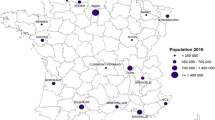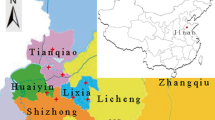Abstract
The deleterious effects of air pollution on children’s health are broadly discussed in the literature. Among pollutants, the Particulate Matter with diameter \(<{10}\,\upmu \hbox {m}\) (\(\hbox {PM}_{10}\)) is usually associated with an increase in the number of children’s hospital admissions. In this paper, we have assumed that, at low concentrations, there is no effect of the former on the latter, and from an unknown concentration threshold, the admissions would be positively affected by \(\hbox {PM}_{10}\). As far as we know, this scenario has never been explored before. In this study, the number of children (10 years and younger) daily admitted with respiratory diseases, the daily average concentration of the \(\hbox {PM}_{10}\) pollutant and meteorological variables collected in the period of January 2010–August 2014, and a deterministic factor for workdays and days off are considered in the model. In order to deal with the lack of information regarding the residence of the children, regularized canonical correlation analysis was used to select only admissions from address codes with higher correlations with \(\hbox {PM}_{10}\) collected from the considered monitoring station. To explain the assumed behavior and estimate the \(\hbox {PM}_{10}\) threshold, we used segmented regression analysis for count data. The Negative Binomial segmented model provided a better fit. Despite data limitations, this framework proves to be a promising modeling strategy, since it is able to provide an explicit estimate for a threshold of \(\hbox {PM}_{10}\) exposure. Another important finding is that the inadequate adjustment by non-segmented models would underestimate the number of expected hospital admissions for concentrations far from the threshold, which in a cumulative aspect may lead to an inaccurate hospital management. We also developed a Monte Carlo experiment to investigate the effects of misfitting the segmented behavior by classic count models, which ratified the findings in application.







Similar content being viewed by others
References
Amancio CT, Nascimento LFC, Amancio TT (2012) Environmental pollutants and odds of hospitalization for asthma in children - São José dos Campos, Brazil, in the years 2004–2005. J Hum Growth Dev 22(2):202–208
Anderson JO, Thundiyil JG, Stolbach A (2012) Clearing the air: a review of the effects of particulate matter air pollution on human health. J Med Toxicol 8(2):166–175
Bacher R, Leng N, Chu L-F, Ni Z, Thomson JA, Kendziorski C, Stewart R (2018) Trendy: segmented regression analysis of expression dynamics in high-throughput ordered profiling experiments. BMC Bioinform 19(1):380
Balmes JR, Fine JM, Sheppard D (1987) Symptomatic bronchoconstriction after short-term inhalation of sulfur dioxide. Am Rev Respiry Dis 136:1117–1121
Bartoletti S, Loperfido N (2010) Modelling air pollution data by the skew-normal distribution. Stoch Environ Res Risk Assess 24(4):513–517
Borges P, Godoi LG (2019) Pólya-aeppli regression model for overdispersed count data. Stat Modelling 19(4):362–385
Chen R, Chu C, Tan J, Cao J, Song W, Xu X, Jiang C, Ma W, Yang C, Chen B et al (2010) Ambient air pollution and hospital admission in Shanghai China. J Hazard Mater 181(1–3):234–240
Chen Y (2020) Jump or kink: on super-efficiency in segmented linear regression breakpoint estimation. Biometrika. https://doi.org/10.1093/biomet/asaa049
Cruz-Cano R, Lee M-L (2014) Fast regularized canonical correlation analysis. Comput Stat Data Anal 70:88–100
Czado C, Gneiting T, Held L (2009) Predictive model assessment for count data. Biometrics 65:1254–1261
Das R, Banerjee M, Nan B, Zheng H (2016) Fast estimation of regression parameters in a broken-stick model for longitudinal data. J Am Stat Assoc 111(515):1132–1143
Feder PI (1975) On asymptotic distribution theory in segmented regression problems-identified case. Ann Stat 3(1):49–83
Gneiting T, Raftery AE (2007) Strictly proper scoring rules, prediction, and estimation. J Am Stat Assoc 102(477):359–378
Governo do Estado do Espírito Santo. Decreto \(n^\circ\). 3463-R, de 16 de dezembro de, (2013) estabelece novos padrões de qualidade do ar e dá providências correlatas. Technical report, Estado do Espírito Santo, p 2013
Hinde J, Demetrio CGB (2000) Overdispersion: models and estimation. University of California at Berkeley, Berkeley, p 110
Hotelling H (1936) Relations between two sets of variates. Biometrika 28(3/4):321–377
Johnson RA, Wichern DW (2007) Applied multivariate statistical analysis, 6th edn. Prentice Hall, New Jersey
Kagawa J (1985) Evaluation of biological significance of nitrogen oxides exposure. Tokai J Exp Clin Med 10(4):348–353
Lagravinese R, Moscone F, Tosetti E, Lee H (2014) The impact of air pollution on hospital admissions: evidence from Italy. Reg Sci Urban Econ 49:278–285
Leurgans SE, Moyeed RA, Silverman BW (1993) Canonical correlation analysis when the data are curves. J R Stat Soc Ser B 55:725–740
Li HL, Huang GH, Zou Y (2008) An integrated fuzzy-stochastic modeling approach for assessing health-impact risk from air pollution. Stoch Environ Res Risk Assess 22(6):789–803
Machin AB, Nascimento LFC (2018) Effects of exposure to air pollutants on children’s health in Cuiabá, Mato Grosso State Brazil. Cadernos de Saúde Pública 34(3):e00006617
McCullagh P, Nelder JA (1989) Generalized linear models, 2nd edn. Chapman & Hall/CRC, Boca Raton, FL
Muggeo VM (2003) Estimating regression models with unknown break-points. Stat Med 22(19):3055–3071
Muggeo VM (2008) Segmented: an R package to fit regression models with broken-line relationships. R News 8(1):20–25
Muggeo VM (2017) Interval estimation for the breakpoint in segmented regression: a smoothed score-based approach. Aust N Z J Stat 59(3):311–322
Muñoz E, Martin M, Turias I, Jimenez-Come M, Trujillo F (2014) Prediction of PM10 and SO2 exceedances to control air pollution in the Bay of Algeciras, Spain. Stoch Environ Res Assess 28(6):1409–1420
Navares R, Díaz J, Linares C, Aznarte JL (2018) Comparing ARIMA and computational intelligence methods to forecast daily hospital admissions due to circulatory and respiratory causes in Madrid. Stoch Environ Res Risk Assess 32(10):2849–2859
Nelder JA, Wedderburn RWM (1972) Generalized linear models. J R Stat Soc Ser A 135(3):370–384
Oliveira MS, Santana MFE, Mattos IE, Leon AP (2016) Association between air pollution and hospital admission from respiratory disease: construction of basics parameters to assess the impact of national policy environmental health surveillance related to air quality in Brazil. Am Int J Biol 4(1):1–19
Riediker M, Cascio WE, Griggs TR, Herbst MC, Bromberg PA, Neas L, Williams RW, Devlin RB (2004) Particulate matter exposure in cars is associated with cardiovascular effects in healthy young men. Am J Res Crit Care Med 169(8):934–940
Ropkins K, Tate JE (2020) Early observations on the impact of the COVID-19 lockdown on air quality trends across the UK. Sci Total Environ 754:142374
Sarnaglia AJQ, Monroy NAJ, da Vitória AG (2018) Modeling and forecasting daily maximum hourly ozone concentrations using the regar model with skewed and heavy-tailed innovations. Environ Ecol Stat 25(4):443–469
Slama A, Śliwczyński A, Woźnica J, Zdrolik M, Wiśnicki B, Kubajek J, Turżańska-Wieczorek O, Gozdowski D, Wierzba W, Franek E (2019) Impact of air pollution on hospital admissions with a focus on respiratory diseases: a time-series multi-city analysis. Environ Sci Pollut Res 26(17):16998–17009
Son J-Y, Lee J-T, Park YH, Bell ML (2013) Short-term effects of air pollution on hospital admissions in Korea. Epidemiology 1:545–554
Tapsoba JDD, Wang C-Y, Zangeneh S, Chen YQ (2020) Methods for generalized change-point models: with applications to human immunodeficiency virus surveillance and diabetes data. Stat Med 39(8):1167–1182
Tsuda A, Donaghey TC, Konduru NV, Pyrgiotakis G, Van Winkle LS, Zhang Z, Edwards P, Bustamante J-M, Brain JD, Demokritou P (2019) Age-dependent translocation of gold nanoparticles across the air-blood barrier. ACS Nano 13(9):10095–10102
Uysal N, Schapira RM (2003) Effects of ozone on lung function and lung diseases. Curr Opin Pulm Med 9(2):144–150
Vinod H (1976) Canonical ridge and econometrics of joint production. J Econ 4(2):147–166
Wellenius GA, Schwartz J, Mittleman MA (2005) Air pollution and hospital admissions for ischemic and hemorrhagic stroke among medicare beneficiaries. Stroke 36(12):2549–2553
WHO (2006) Air quality guidelines: global update 2005: particulate matter, ozone, nitrogen dioxide, and sulfur dioxide. World Health Organization
Wiwanitkit V (2008) PM10 in the atmosphere and incidence of respiratory illness in Chiangmai during the smoggy pollution. Stoch Environ Res Risk Assess 22(3):437–440
Zeileis A, Kleiber C, Jackman S (2008) Regression models for count data in R. J Stat Softw 27(8):1–25
Acknowledgements
The authors would like to thank the Nossa Senhora da Glória Children’s Hospital for providing the data related to the number of hospitalizations and to IEMA for making freely available air pollution and meteorological variables.
Author information
Authors and Affiliations
Corresponding author
Additional information
Publisher's Note
Springer Nature remains neutral with regard to jurisdictional claims in published maps and institutional affiliations.
Appendix
Appendix
In this section, we present the complementary results of the simulation experiment. This information regards to the Mean and the RMSE of the estimates (Tables 9 and 10) under the NB scenario, and the frequency of inadmissible \(\psi\) values (Table 11).
Rights and permissions
About this article
Cite this article
Sarnaglia, A.J.Q., Godoi, L.G. & Rodrigues, M.C. Estimating critical level of \(\hbox {PM}_{{10}}\) to affect hospital infant admissions in Vitória, Brazil. Stoch Environ Res Risk Assess 35, 2031–2048 (2021). https://doi.org/10.1007/s00477-021-01979-1
Accepted:
Published:
Issue Date:
DOI: https://doi.org/10.1007/s00477-021-01979-1




